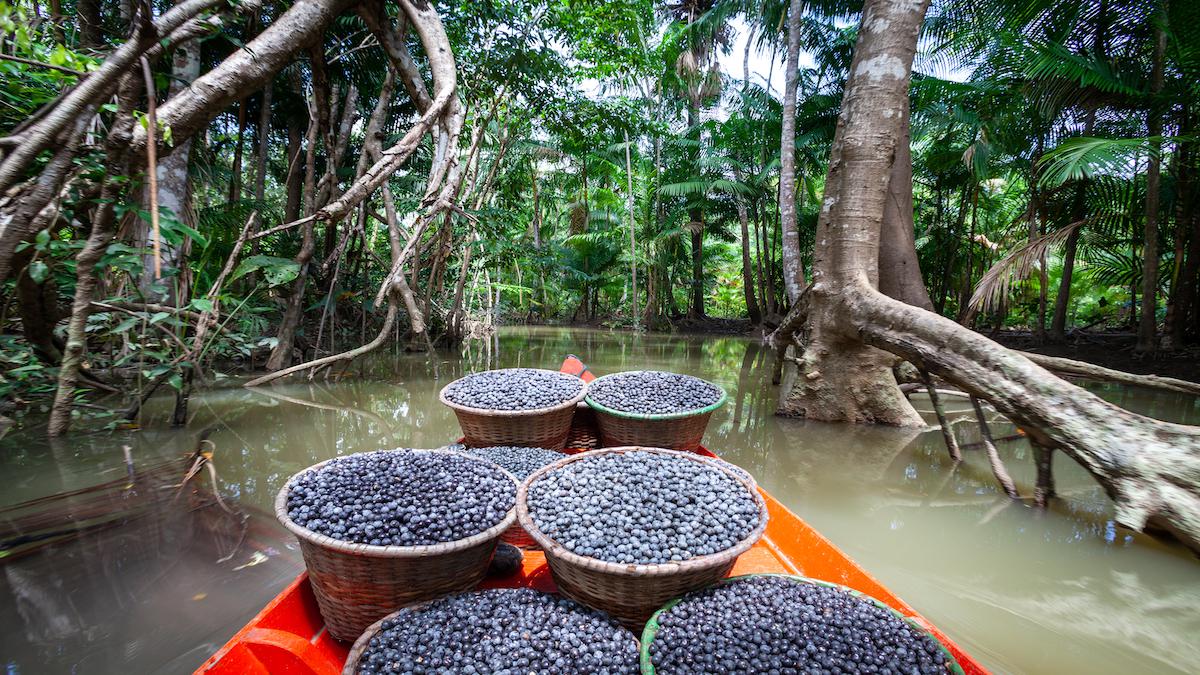

Fresh acai berries on a boat in the Amazon rainforest in Brazil. Paralaxis / iStock / Getty Images Plus
Açaí has long been consumed by locals in the Amazon region, but as global interest in this berry increases, more resources are required to produce it.
A new study in Biological Conservation has found that the increase in açaí palm agriculture is causing biodiversity loss by changing plant life and important estuarine forests in the Amazon.
In the past decade alone, açaí exports have increased 14,380% from 40 tons to nearly 6,000 tons. According to Mongabay, the sector grew 51% in 2019 and 2020. From supplemental powders to smoothie bowls, global demand is skyrocketing for the fruit, which has been called a superfood. This term is mainly for marketing purposes but refers to foods that are considered nutritionally dense, which are ever-popular in a wellness-focused world.
“Before the açaí boom, there was always domestic production to meet local demand,” Ima Vieira, ecologist and co-author of the study, told Mongabay. “Until that point, this symbol of the Amazonian food tradition had little impact, but once it grew in fame and demand, the situation changed.”
The increased demand for açaí has meant booming economic opportunities for locals in Pará, a state in the Amazon that is the largest exporter for this berry. Pará is also the primary domestic consumer for açaí. But to produce more berries, native trees in the Amazon’s estuarine forests must be cut down to make room for the açaí palms. The palms require intense light and a lot of water to grow, so planting them in floodplains is best for higher yields. In this process of creating monocultures, biodiversity loss abounds and the landscape changes for the worse.
“Our results suggest that açaí intensification alters the structure of woody plant assemblages in estuarine forest,” the study says. “Tree abundance and species richness consistently declines as açaí clump density increases, with some forest stands being dominated by açaí and almost lacking any tree species. Accordingly, landscapes dominated by high-intensity forest stands are largely impoverished in terms of understory, canopy and emergent tree species.”
In 2013, Pará’s environmental department set limits on the number of açaí palms that can be cultivated and harvested in a given area to prevent disrupting species in floodplain forests. But the reality is that these limits are largely not followed or enforced. The limits specify that farmers may cultivate 400 sets of plants, called clusters, and harvest 200 palms per hectare.
The study researchers found around 1,000 sets of plants per hectare. Even the state guidance for limiting clusters to 400 per hectare can result in biodiversity loss of 60% or more.
The researchers are calling for more regulation and sustainable agriculture training for local farmers in order to provide economic opportunities while not destroying the unique and vulnerable environment.
“From an economic and social point of view, there’s no question that increased demand has greatly improved the lives of riverside dwellers. This is why we need to be careful with public policy,” Vieira said. “Attempting to reconcile forest conservation and local development by intensifying the production of non-timber forest products in the Amazon may result in unsuccessful actions due to limited understanding of the complexity of the factors that affect this production.”

 233k
233k  41k
41k  Subscribe
Subscribe 